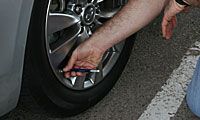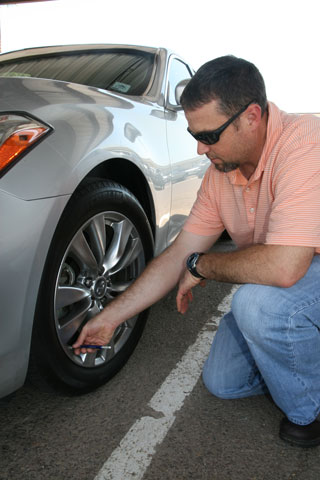There’s a lot riding on your tires, including your safety
There’s a lot riding on your tires, including your safety

It is important for all drivers to inspect tires routinely.
By Jennifer Toth
ADOT Deputy Director for Transportation
Did you know that your safety, and the safety of your passengers and other drivers, could be riding on your tires?
The role of tires in transportation safety has been a major topic for lawmakers, and car makers, for the past several years.
About a decade ago, researchers attributed more than 74,000 crashes a year to blowouts and flat tires.
In 2000, the federal Transportation Recall Enhancement, Accountability and Documentation Act (TREAD) mandated the installation of tire pressure monitoring systems (TPMS) in vehicles manufactured after 2007.
Today, TPMS alert drivers to an underinflated tire. The required TPMS is the reason why you might see a warning light illuminate in your vehicle nowadays. It’s more than a courtesy; it’s a tool designed to prevent crashes, reduce injuries and save lives.
Even if your vehicle has a TPMS, you should inspect all four tires and the spare regularly, advises Lionel McFarlane, ADOT’s safety liaison for Equipment Services.
Check your tires before a road trip and at least once a month for the following:
Correct tire pressure: Maintain the recommended tire pressure in all four tires. You can find the recommended tire pressure on the sticker or placard inside your vehicle door or in the owner’s manual for your vehicle.
- Always use an accurate tire pressure gauge. You can’t always tell just by looking if a tire is under- or over-inflated;
- Check tire pressure when the tires are cold (about three hours after your last drive).
Uneven or rapid wear: This could signal the need for a wheel alignment. A misalignment can also cause tires to squeal and your vehicle to pull to one side or another.
Road debris: Even new tires sustain damage if you hit or run over debris. Check for nails and screws, glass and metal in the tire surface, shoulder and sidewall.
Cracks and dry, brittle rubber: These are the ugly symptoms of “dry rot,” which requires tire replacement.
Anything out of the ordinary: Check the tire surface, shoulder and sidewall for deep cuts (“gorges”), bubbles that look like air pockets or other anomalies.
Properly fitting valve caps: The valve caps should be on all the time to keep stem clean and prevent you from forcing sand and debris into the tire when you fill it with air.
Enough tread: Tire tread ensures proper traction with the road surface. Tread below 2/32 of an inch means your tires cannot grip the roadway. On a wet road surface you might feel your vehicle slip or “hydroplane,” causing you to slide or lose control. Tires have a ‘wear bar’ so you know when the tread is below 2/32 of an inch.
- Try the coin test. Put an upside-down penny or quarter in your tread. If the president’s head is covered, you have more than 2/32 of an inch of tread remaining. If you can see the president’s head, you’re tread is too low.
- For maximum traction on wet roads, consider replacing tires when the tread reaches 4/32 of an inch; if snow is a concern, keep the tread above 6/32 of an inch.
Keep in mind: There’s no set time-frame for your tires to last. Their lifespan depends on your driving habits, driving conditions and factors outside your control, such as running over a nail. That’s why it is so important for all drivers to inspect tires routinely and repair or replace them as needed.

